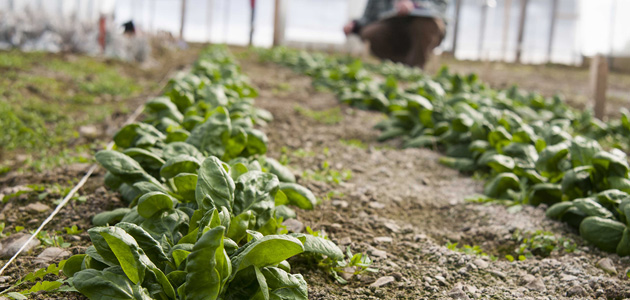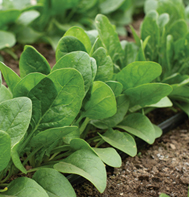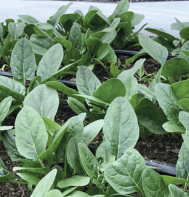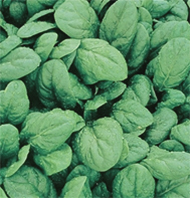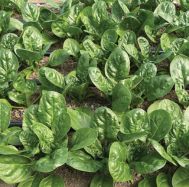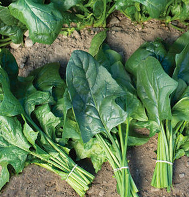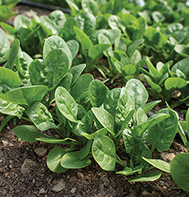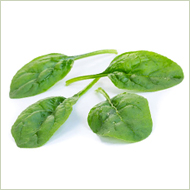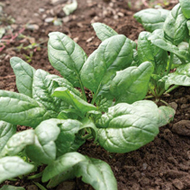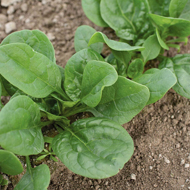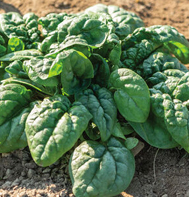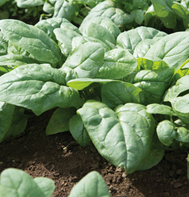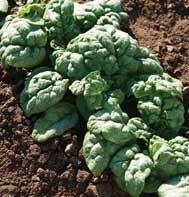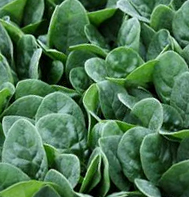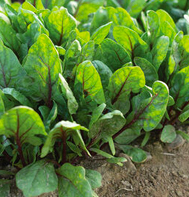- Video: Baby Leaf Greens: 12 Picks for Market Growers | Johnny's Webinar Series
- Spinach Seed Roller Pack | Tech Sheet (PDF)
- Winter Growing | Recommended Crops & Varieties
- Baby Leaf Greens: 12 Picks for Market Growers | Johnny's Educational Webinar Resources
- Video: Johnny's Season Extension & Overwintering Trials
- Video: Baby Leaf Harvester for Greens, Mesclun, Spinach, Lettuces & Tender Aromatics
- Johnny's Planting & Harvesting Programs
- Spinach | Key Growing Information
- Spinach Varieties | Succession Planting Program
- Spinach Varieties | Comparison Chart / Planting Program (PDF)
- Baby Leaf Greens & Baby Leaf Lettuce | Technical Production Guide
Johnny's SPINACH Planting Program
Spinach Succession Planting & Season Extension
Johnny's Spinach Planting Program is designed to illustrate which spinach varieties to plant, grow, and harvest in sequence, allowing you to extend your spinach harvest across the seasons. Slow-growing spinach varieties mature best under warm conditions, whereas faster-growing varieties mature best under cooler conditions.
Establish your spinach production plan by evaluating the sowing and harvesting slots indicated in the charts below. Additional key distinguishing features include leaf shape (round, oval, arrowhead), texture (smooth, semi-savoyed, savoyed), and color; days to maturity (DTM figures are for "farmer's market baby leaf size"); growth rate and tendency to bolt; and disease resistances, including strains of downy mildew and white rust.
NOTES
- Resistances to downy mildew races are high (HR) unless otherwise noted.
- Varieties are listed in order of increasing number of days to maturity.
- Broccoli • Standard Heading Varieties • Planting Program
- Broccoli • Mini & Sprouting Varieties • Planting Program
- Brussels Sprouts • Planting/Harvesting Program
- Cauliflower • Planting Program
- Leeks • Planting/Harvesting Program
- Lettuce • Full-size Head Varieties • Planting Program
- Radicchio • Planting Program
- Radish • Specialty & Daikon Varieties • Planting Program
- Spinach • Planting Program
- Spinach • Planting Program Comparison Chart • PDF Version
- View ALL Planting Programs
Choose Spinach Varieties by Sowing & Harvesting Periods
Spring
Summer
Fall
Winter
Early Spring
| Leaf | Days to Maturity | Color | Growth Rate | Bolting | Downy Mildew Resistance |
| Upright; smooth | 24 | Dark green | Fast | Fast | Races 1–12, 14–16, 19 |
Spring
Summer
Fall
Winter
Early Spring
| Leaf | Days to Maturity | Color | Growth Rate | Bolting | Downy Mildew Resistance |
| Upright; smooth | 24 | Dark green | Fast | Fast | Races 1–12, 14–16, 19 |
Spring
Summer
Fall
Winter
Early Spring
| Leaf | Days to Maturity | Color | Growth Rate | Bolting | Downy Mildew Resistance |
| Upright; smooth to slightly savoyed | 25 | Medium dark green | Fast | Medium | Races 1–3, 5–6, 8–9, 11–12, 14, 16, 19 |
Spring
Summer
Fall
Winter
Early Spring
| Leaf | Days to Maturity | Color | Growth Rate | Bolting | Downy Mildew Resistance |
| Semi-savoyed | 27 | Medium dark green | Fast | Medium | Races 1–7, 9–20 |
Spring
Summer
Fall
Winter
Early Spring
| Leaf | Days to Maturity | Color | Growth Rate | Bolting | Downy Mildew Resistance |
| Arrowhead; long-stemmed; uniform, smooth | 27 | Medium green | Fast | Medium | Races 1–14, 16 |
Spring
Summer
Fall
Winter
Early Spring
| Leaf | Days to Maturity | Color | Growth Rate | Bolting | Disease Resistance |
| Fully savoyed; slightly elongate, round, cupped | 27 | Medium dark green | Fast | Fast | Downy Mildew Races 1–12, 14–16, 19 IR: WR (White Rust) |
Spring
Summer
Fall
Winter
Early Spring
| Leaf | Days to Maturity | Color | Growth Rate | Bolting | Downy Mildew Resistance |
| Semi-savoyed | 27 | Medium green | Fast | Medium | Races 1–16, 19 |
Spring
Summer
Fall
Winter
Early Spring
| Leaf | Days to Maturity | Color | Growth Rate | Bolting | Disease Resistance |
| Slightly cupped; heavily savoyed, though not quite a full savoy in the winter tunnel | 27 | Medium dark green | Fast | Medium | HR: Downy Mildew Races 1–9, 11–19; IR: Downy Mildew Race 10 IR: WR (White Rust) |
Spring
Summer
Fall
Winter
Early Spring
| Leaf | Days to Maturity | Color | Growth Rate | Bolting | Downy Mildew Resistance |
| Elongate-oval, upright, semi-savoy | 27 | Glossy dark green | Slow | Medium | HR: Races 1–13, 15–16, 18 |
Spring
Summer
Fall
Winter
Early Spring
| Leaf | Days to Maturity | Color | Growth Rate | Bolting | Downy Mildew Resistance |
| Smooth, round, full, and thick | 28 | Dark green | Slow | Slow | HR: Races 1–15, 17 |
Spring
Summer
Fall
Winter
Early Spring
| Leaf | Days to Maturity | Color | Growth Rate | Bolting | Downy Mildew Resistance |
| Fully savoyed, on long stems | 28 | Medium dark green | Medium | Medium | — |
Spring
Summer
Fall
Winter
Early Spring
| Leaf | Days to Maturity | Color | Growth Rate | Bolting | Downy Mildew Resistance |
| Semi-savoyed | 29 | Medium dark green | Medium | Medium | Races 1–9, 12–15, 17; IR: 10–11 |
Spring
Summer
Fall
Winter
Early Spring
| Leaf | Days to Maturity | Color | Growth Rate | Bolting | Downy Mildew Resistance |
| Heavily savoyed | 30 | Medium dark green | Medium to Fast | Fast | — |
Spring
Summer
Fall
Winter
Early Spring
| Leaf | Days to Maturity | Color | Growth Rate | Bolting | Downy Mildew Resistance |
| Smooth, thick, small, spade-shaped | 30 | Dark green | Slow | Slow | HR: Races 1–11, 15–16, 19; IR: 12, 14 |
Spring
Summer
Fall
Winter
Early Spring
| Leaf | Days to Maturity | Color | Growth Rate | Bolting | Downy Mildew Resistance |
| Smooth, with an angular shape and upright habit | 31 | Dark green, with bright-red veins | Slow | Slow | HR: Races 1–9, 11–13; IR: 10 |
Tech Tip: Winter Spinach Production
At higher latitudes, such as here in Albion, Maine, spinach can be grown in a hoophouse right through winter. The key is to have the spinach established before the day length drops below 10 hours, after which growth rate slows to a standstill but tolerance to cold temperatures remains in effect, allowing for winter harvest and overwintering for early spring harvest.
Seeding for winter production occurs during the warmest weeks of the year, when spinach traditionally performs poorly. Keep the soil moist and cool, but monitor well to prevent damping off. Irrigating the soil cools it in two ways: first, by physically cooling the soil with cold water; and second, through evapotranspiration, whereby evaporation draws heat from the soil.


